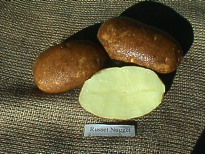
 |
Description | |
| Tuber Shape | Oblong | |
| Eyes | Shallow evenly distributed eyes | |
| Skin | Smooth medium russet | |
| Flesh | White | |
| Plant | Large sized upright vine with many white flowers | |
Russet Nugget is a late-maturing fresh market/processing potato released in 1988 by ColoradoState University (APJ 69:331-336, 1 992). It ranks high in all taste tests. Levels of Vitamin Calso are high (35.0 mg/l 00g, fresh weight basis).
Plant/root Plants emerge quickly and produce a vine that is large and erect with abundant whiteflowers and an indeterminate growth habit. A deep spreading root system helps provide adequatewater and nutrient uptake for the large vines. Hail damage generally is minimal.
Tubers have creamy white flesh and are oblong with a light russet skin. Eyes are shallow andwell distributed; tubers consistently have high specific gravity (1 . 1 00).
Yield potential 400 to 450 cwt. range with a high percentage of No. l's.
Irrigation Irrigation interval at the maximum ET is 3 to 3.5 days. Drought tolerance is excellent. Overly abundant water, late in the growing season, coupled with excessive nitrogen, on soils with relatively high salt content, can result in alligator hide on the tubers.
Fungicides Control of foliar early blight usually is accomplished with one fungicide application,but, sometimes none are required.
Tuber/bulking Tubers set in the middle of the hill and spread throughout by the end of the season. Under proper fertility, rapid bulking occurs relatively late. Tubers are resistant to hollow heart,second growth, blackspot and shatter bruise.
Vine kill Average days from planting to vine kill are 120 +. Vine killing is required. Excessive N can delay maturity making this operation much more difficult. However, once mature, vine killing is readily accomplished. Adequate skin set occurs within 14 to 21 days.
| Field | Storage |
| Foliar early blight: Moderately Reistant | Tuber early blight Moderate Resistant |
| Verticillium wilt: Moderately Resistant | Bacterial soft rot Susceptible |
| Blackleg Moderately Susceptible | Fusarium dry rot Susceptible |
| Seedpiece decay Susceptible | Leak (Pythium) Susceptible |
| Leafroll virus Moderately Susceptible | Pink rot (Phytophthora) Susceptible |
| Leafroll Net necrosis Moderately Resistant | Silver scurf Unknown |
| PVY, PVX Susceptible | Rhizoctonia scurf Moderately Susceptible |
| Bacterial ring rot Susceptible | |
| Common Scab Resistant |
Disease reaction ratings susceptible, moderately susceptible, moderate, moderately resistant andresistant,